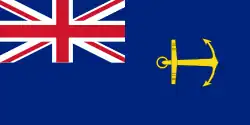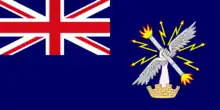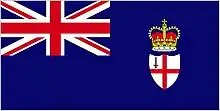 | |
| Use | State ensign |
|---|---|
| Proportion | 1:2 |
| Adopted | British Government |
| Design | A blue field with the Union occupying one quarter of the field and placed in the canton. |

The Blue Ensign is a flag, one of several British ensigns, used by certain organisations or territories associated or formerly associated with the United Kingdom. It is used either plain or defaced with a badge or other emblem.
The evolution of the Blue Ensign followed that of the Union Jack. The ensign originated in the 17th century with the St George's Cross (the Flag of England) in the canton, and with a blue field.
The Acts of Union 1707 united England and Wales with Scotland in the Kingdom of Great Britain, thus producing a new Blue Ensign with the new Union Flag, containing a saltire, in the canton. With the Act of Union 1800, Ireland became a part of the new United Kingdom of Great Britain and Ireland, and St Patrick's Cross was incorporated into the Union Flag and, accordingly, into the cantons of all British ensigns from 1 January 1801.

 The modern Blue Ensign of the United Kingdom
The modern Blue Ensign of the United Kingdom.svg.png.webp)
 The British Blue Ensign (1707–1801)
The British Blue Ensign (1707–1801)
 English Blue Ensign as it appeared in the seventeenth century
English Blue Ensign as it appeared in the seventeenth century
Plain Blue Ensign
Prior to the reorganisation of the Royal Navy in 1864, the plain blue ensign had been the ensign of one of three squadrons of the Royal Navy, the Blue Squadron. This changed in 1864, when an order in council provided that the Red Ensign was allocated to merchantmen, the Blue Ensign was to be the flag of ships in public service or commanded by an officer in the Royal Naval Reserve, and the White Ensign was allocated to the Navy.
Thus, since 1864, the plain blue ensign (without any defacement or modification) is permitted to be worn, instead of the Red Ensign, by three categories of civilian vessel:[1]
- British merchant vessels whose officers and crew include a certain number of retired Royal Navy personnel or Royal Naval Reservists, or are commanded by an officer of the Royal Naval Reserve in possession of a Government warrant. The number and rank of such crew members required has varied over the years, as have the additional conditions required, since the system was first introduced in 1864.
- Royal Research Ships by warrant[lower-alpha 1] whether crewed by former Royal Navy personnel or Merchant Navy personnel.
- British-registered yachts belonging to members of the following yacht clubs:[2]
- Hornet Services Sailing Club
- Royal Naval Club and Royal Albert Yacht Club
- Royal Brighton Yacht Club, Victoria
- Royal British Virgin Islands Yacht Club
- Royal Cinque Ports Yacht Club
- Royal Cruising Club
- Royal Dorset Yacht Club
- Royal Engineer Yacht Club
- Royal Geelong Yacht Club, Victoria
- Royal Gourock Yacht Club
- Royal Highland Yacht Club
- Royal Marines Sailing Club
- Royal Melbourne Yacht Squadron, Victoria
- Royal Motor Yacht Club
- Royal Naval Sailing Association
- Royal Naval Volunteer Reserve Yacht Club
- Royal New Zealand Yacht Squadron
- Royal Perth Yacht Club, Western Australia
- Royal Northern and Clyde Yacht Club
- Royal Port Nicholson Yacht Club, New Zealand
- Royal Queensland Yacht Squadron
- Royal Scottish Motor Yacht Club
- Royal Solent Yacht Club
- Royal South Australia Yacht Squadron
- Royal Southern Yacht Club
- Royal Sydney Yacht Squadron, New South Wales
- Royal Temple Yacht Club
- Royal Thames Yacht Club
- Royal Victorian Motor Yacht Club
- Royal Welsh Yacht Club
- Royal Western Yacht Club of England
- Royal Western Yacht Club of Scotland
- Royal Yacht Club of Tasmania
- Royal Yacht Club of Victoria
- Sussex Motor Yacht Club
- The Cruising Association
Permission for yachts to wear the blue ensign (and other special yachting ensigns) was suspended during both World War I and World War II.
Defaced Blue Ensign
Since 1864, the Blue Ensign is defaced with a badge or emblem, to form the ensign of United Kingdom government departments or public bodies. Current defaced Blue Ensigns (besides yacht clubs listed below) are:
Royal Air Force marine vessels (such as seaplane tenders) flew a defaced blue ensign with an eagle and anchor.[3]
Yachting Blue Ensigns defaced by the badge of the club were recorded in the Navy List until 1985, and now they are administered by the Royal Yachting Association for the Ministry of Defence. Current defaced Blue Ensigns are:[4]
Flags of the Crown Dependencies using defaced Blue Ensigns
Flags of British Overseas Territories using defaced Blue Ensigns
Current flags:
 Flag of Anguilla
Flag of Anguilla Government Ensign of Bermuda (the flag commonly used on land is Bermuda's Red Ensign)
Government Ensign of Bermuda (the flag commonly used on land is Bermuda's Red Ensign) Flag of the British Virgin Islands
Flag of the British Virgin Islands Flag of the Cayman Islands
Flag of the Cayman Islands Flag of the Falkland Islands
Flag of the Falkland Islands Government Ensign of Gibraltar (there is another flag, not based on an ensign, that is commonly used on land)
Government Ensign of Gibraltar (there is another flag, not based on an ensign, that is commonly used on land) Flag of Montserrat
Flag of Montserrat Flag of the Pitcairn Islands
Flag of the Pitcairn Islands Flag of Saint Helena
Flag of Saint Helena Flag of the Turks and Caicos Islands
Flag of the Turks and Caicos Islands
Former flags:
The defaced blue ensign was formerly used as:
- Flag of Bengal Presidency

 Bengal Presidency flag, 1612–1947
Bengal Presidency flag, 1612–1947
- The flag of the Gilbert and Ellice Islands Colony from 1937 to 1976, then the flag of the Gilbert Islands (1976–1979)
- The jack of the Royal Canadian Navy from its inception until the adoption of the Maple Leaf flag in 1965[5] The blue ensign was approved by the British Admiralty in 1868 for use by ships owned by the Canadian government.
.svg.png.webp)
 Blue Ensign worn as a jack by the Royal Canadian Navy 1921–1957 (with green maple leaves in the shield)
Blue Ensign worn as a jack by the Royal Canadian Navy 1921–1957 (with green maple leaves in the shield).svg.png.webp)
 Blue Ensign worn as a jack by the Royal Canadian Navy 1957–1965 (with red maple leaves in the shield)
Blue Ensign worn as a jack by the Royal Canadian Navy 1957–1965 (with red maple leaves in the shield)
- The ensign (1879–1928) and the jack (1928–1947) of the Royal Indian Navy (HM Indian Marine: 1879–1892, Royal Indian Marine: 1892–1934, Royal Indian Navy: 1934–1950):
 Flag of the United States of the Ionian Islands (a British amical protectorate, 1815–1864)
Flag of the United States of the Ionian Islands (a British amical protectorate, 1815–1864).svg.png.webp) Flag of British Hong Kong (1870–1997) and the ensign of the Royal Hong Kong Police Force
Flag of British Hong Kong (1870–1997) and the ensign of the Royal Hong Kong Police Force Flag of Weihaiwei (1903–1930)
Flag of Weihaiwei (1903–1930)- Newfoundland
.svg.png.webp)
 Newfoundland Blue Ensign, 1870–1904
Newfoundland Blue Ensign, 1870–1904
 Newfoundland Blue Ensign, 1904–1931
Newfoundland Blue Ensign, 1904–1931
- The ensign (1910–1928) of the Union of South Africa:
.svg.png.webp)
 Blue Ensign flown over the Union's offices abroad, 1910–1928
Blue Ensign flown over the Union's offices abroad, 1910–1928
National flags based on the Blue Ensign
These include:
Other flags based on the Blue Ensign
.svg.png.webp) Flag of Ceylon
Flag of Ceylon- Ensign of The Royal Hospital School
.svg.png.webp) George Rex Flag
George Rex Flag.svg.png.webp) Tanganyika Territory blue ensign
Tanganyika Territory blue ensign Fijian government ensign
Fijian government ensign
 Fijian customs ensign
Fijian customs ensign
 Flag of Australasia team at the Olympic games
Flag of Australasia team at the Olympic games Flag of the Blood 148 Kainai Nation of Alberta, Canada
Flag of the Blood 148 Kainai Nation of Alberta, Canada Flag of Britain First Party
Flag of Britain First Party
See also
References
- Notes
- ↑ An individual warrant is issued by the Secretary of State for Defence for each ship
- Footnotes
- ↑ Naval Staff Directorate. "Naval Flags and Ensigns" (PDF). p. 12. Archived from the original (PDF) on 6 June 2014. Retrieved 1 January 2013.
- ↑ UK Ministry of Defence. "The Navy Directory 2019" (PDF). p. 30. Retrieved 15 April 2021.
- ↑ "RAF Marine Vessel Ensign". Flying Colours Flagmakers. Retrieved 9 January 2022.
- ↑ UK Ministry of Defence. "The Navy Directory 2019" (PDF). p. 31. Retrieved 15 April 2021.
- ↑ "Flags of the Royal Canadian Navy 1910–1965".
- ↑ Flags of the World: British India
External links
- Blue Ensign page on the "Flags of the World" website
- UK, Naval, Government, Yacht clubs on flags.net



.svg.png.webp)





























